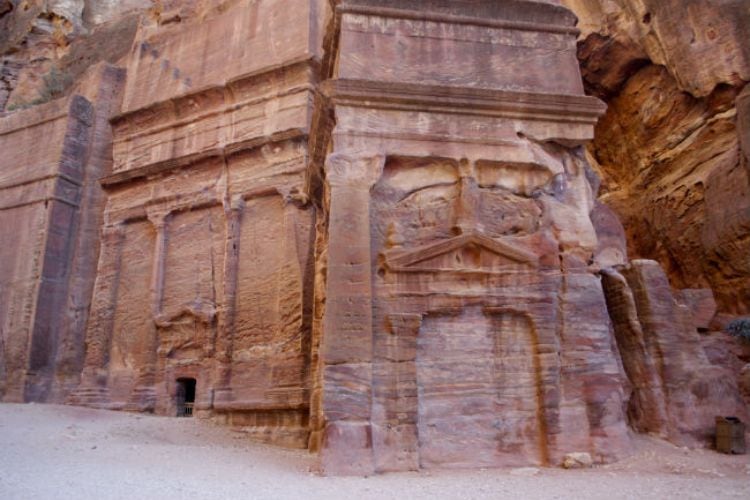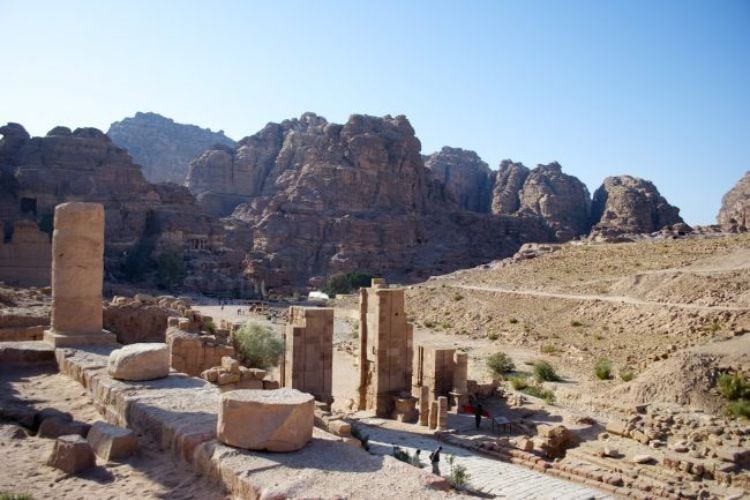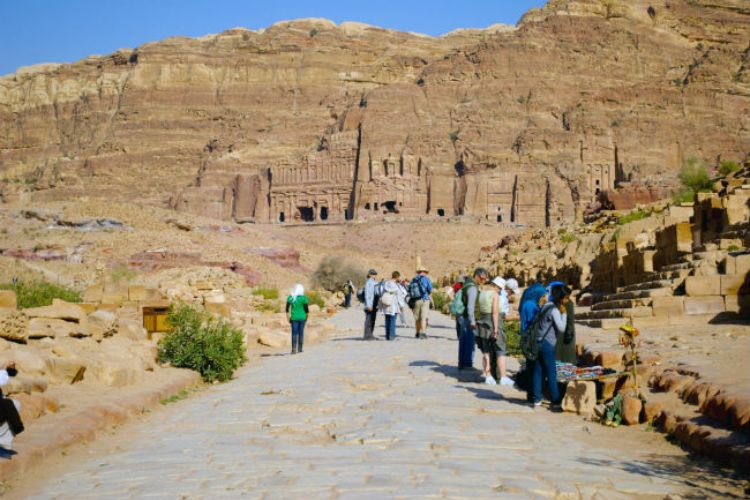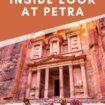
The once lost city of Petra, hidden in a deep canyon in southwest Jordan, is an archaeological site rivaling any in the world for its grandness, artistry and compelling history dating back to 400 BC. At one time, 20,000 people lived in Petra, known as the Rose City for its pastel rock walls.
Although many civilizations have been part of Petra’s history, it was the ancient Nabataeans who created the mesmerizing facades seen across the canyon today.
Exploring Petra—the most popular attraction in Jordan—requires walking long distances in desert heat. The route from the visitor center past the city’s main sites and back is approximately six miles. Go early in the morning to avoid the high heat of the day and take water.
Visit Little Petra, too, the nearby, more compact site that serves as a good entry point to understanding Petra’s history and carvings.
A few miles north of Petra is Little Petra, in the land of the Ammareen people. Although it doesn’t have the grand scale of its more famous neighbor, Little Petra, most likely an ancient caravan staging area for Petra, has charm of its own.
1. Up Close in Little Petra’s Ruins

Little Petra’s quieter, more intimate setting includes pathways and intriguing carved stairs leading up and around the hills, offering close-up access to carvings and shallow interiors.
2. Contemporary Culture, Ancient Site

Stalls near the entrance to Little Petra are stocked with Bedouin art and wares. There are also Bedouin tent camps nearby that make a good overnight base for those who want to join a guided hike the back way into Petra or simply experience authentic local hospitality.
3. The Painted House in Little Petra

As you walk into the second wide-open area in Little Petra, steep steps on the left lead up to the evocative Painted House. Inside is one of the only Nabataean painted interiors to survive through the centuries, a work of delicate flowers and vines. A cherubic Pan, showing Hellenistic influence, is among the exquisite images still visible.
4. Looking Out Over Jordan

If you’re a hiker, consider walking through the stark, dramatic terrain—up and down steps, along dusty high ridges, through occasional groves of trees—to the back entrance of Petra. The Back Door Trail is about a three-hour hike.
Hiring a guide isn’t mandatory, but it supports the local community, the trail isn’t always obvious, and guides provide context and insight you wouldn’t get on your own. Once in Petra, it’s another three miles through the city to the visitor center.
5. Fear of Heights? This Trail Isn’t For You

The Back Door Trail isn’t extremely difficult, but neither is it for the faint of heart. There are places to test even a skilled hiker’s nerve, places where the trail all but disappears into narrow rock ledges with harrowing drop-offs.
The trail has been improved in recent years. Still, going with a reputable guide is smart. Quality hiking shoes, layers of clothing and plenty of water are a must.
6. Deserving of the Term “Iconic”

Most visitors enter Petra via the main gate, following pathways to the siq, a winding slot canyon with towering walls that eventually opens up to Petra’s masterpiece, the Treasury, Al-Khazneh.
Unlike Hollywood’s version in Indian Jones and the Last Crusade, there are no vast rooms beyond the doorway, no priceless artifacts.
The true treasure here is the artistry of the complex exterior. Although crowded, the candlelit nighttime shows add a mystical quality (and a separate fee).
Those who hike into Petra from the back reach the Treasury in late afternoon light, without crowds, and with time to ponder its mysteries.
Tours and Tickets to Experience Petra
7. Look Up

For those entering or leaving Petra via the main gate, look up as you stroll the one-mile route between the gate and the Treasury.
The Nabataeans who created Petra touched nearly every available rock surface. These tombs are eroded yet still evocative, especially when bathed in the deepening light of the afternoon sun.
8. Carved, Not Constructed

From a distance, Petra appears to be comprised of structures, the striking ruins of a long-ago city. But these are not buildings. They’re works of art meticulously cut by hand out of the rose-rock walls.
A few have small chambers behind them, primarily used as burial sites, but the doors of most lead to nothing. Petra is an elaborate illusion of gifted artists.
9. Taxi by Camel

If you yearn to ride a camel in a memorable setting, this is it. If you need a break from all the walking, camels deliver.
Drivers and their desert beasts can be found all along the main drag from the Treasury, past the Theater and beyond, waiting to pick up fares. Camels are part of Petra’s long history, as natural here as the sand and stone.
10. In the Footsteps of Romans

Petra was created by the Nabataeans but was also inhabited by Romans and Crusaders, among others, and finally Bedouins. Nowhere is the Roman influence more palpable than on Cardo Maximus, a wide thoroughfare once defined by graceful columns and magnificent gates.
11. Go Off-Road in Petra

There’s every reason to leave the main trail within Petra. There are steps to climb, side paths to explore and natural or manmade features that grow more impressive the closer you look.
These steps lead to the ruins of a Roman temple above Cardo Maximus, hints of its former grandeur still visible.
12. A Convergence of Cultures

Signs of a multitude of cultures converging in Petra are clearly visible as you stroll along the grand Cardo Maximus. Here, the road faces the East Cliff with four ancient Nabataean burial chambers known as the Royal Tombs.
The Silk Tomb’s waves of colored sandstone should be viewed up close. Today, people from across the world walk this road where Petra’s contemporary Bedouin culture thrives, too.
13. Dare to Climb

Like the hikers from Little Petra, visitors who arrive via the main gate also have to climb a bit if they don’t want to miss one of Petra’s grandest sites—the Monastery, 800 steps up from the main walkway.
Walking is the best way to preserve the ancient steps, but if you can’t, you can hire a donkey (for a price).
Your reward for the climb is an astonishing view across the landscape. From here it’s easy to see how Petra is all but invisible—and thus safe from marauders—even when you know its location.
14. The Monastery

The Monastery, Ad-Deir, is arguably the most impressive and powerful façade in all of Petra, not for the intricacies of its carvings but for its staggering grandness.
You have to stand in front of it to truly appreciate its enormity. The doorway alone rises 26 feet. This is one façade with a sizeable room behind it, one reportedly once used by early Christians to practice their religion away from Roman eyes.
15. End of the Trail

After all the ups and downs, the sun and heat and sweat, hikers from Little Petra round a corner to come face-to-face with the Monastery, which seems to rise from nowhere out of the mountain from which it’s carved.
After exploring, hikers then get to saunter down the 800 steps to the canyon floor to view the city for the first time. This is also the turnaround point for those who enter Petra from the main gate, making the final climb up the steps to the top of the cliffs.
As they go back down and through the city, they see it in a new way and new light. From either direction, the Monastery is not to be missed.
Inspire your next adventure with our articles below:
Author Bio: Christine Loomis is a longtime journalist who has covered travel and lifestyle topics for multiple print and online publications. She has been editor-in-chief of three magazines and regularly provides reviews, content, and photo galleries for USA Today 10Best. She serves on the board of the Society of American Travel Writers (SATW).
Want to discover more hidden gems and helpful travel tips? Join our free newsletter for the latest travel secrets and travel articles.
We are reader-supported and may earn a commission on purchases made through links in this article.

